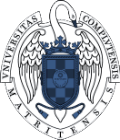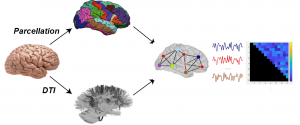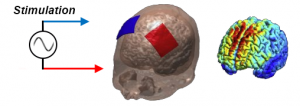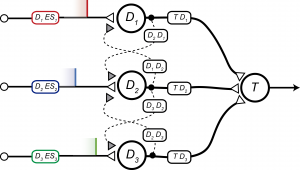![]() Research line coordinated by Gianluca Susi.
Research line coordinated by Gianluca Susi.
Computational neuroscience is an interdisciplinary field which employs mathematical models and theoretical analysis to understand the principles that govern the physiology, structure and development of the nervous system, and related cognitive abilities.
Specifically, in the laboratory we carry out brain network simulations based on real data, aimed at:
1) understanding the mechanisms underlying the progression of neurodegenerative diseases through the study and reproduction of typical functional connectivity patterns and their disruption;
2) designing and testing personalized protocols of non-invasive electrical stimulation (e.g. tACS), focused on the modulation of oscillatory activity and synchronization between specific brain areas.
A parallel activity concerning this research area is the application of brain-inspired processing to address engineering problems.
A publicly available neural network simulator, FNS, has been developed by the laboratory: https://www.fnsneuralsimulator.org/
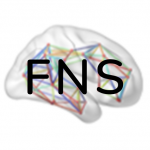
The members of this research line at the Laboratory of Cognitive and Computational Neuroscience are currently participating in the European project Virtual Brain Cloud (GA ID: 826421).
Recent publications:
G. Susi, P. Garcés, E.Paracone, A.Cristini, M.Salerno, F.Maestú, E.Pereda. FNS allows efficient event-driven spiking neural network simulations based on a neuron model supporting spike latency. Sci Rep. 2021 Jun; 11(1):12160.
A. Giovannetti*, G. Susi*, P. Casti, A. Mencattini, S.Pusil, M.E. López, C. Di Natale, E. Martinelli. Deep-MEG: spatiotemporal CNN features and multiband ensemble classification for predicting the early signs of Alzheimer’s disease with magnetoencephalography. Neural Comput & Applic, 2021.
G. Susi, L. Antón, F. Maestú, C. Mirasso. nMNSD—A Spiking Neuron-Based Classifier That Combines Weight-Adjustment and Delay-Shift. Front Neurosci (15) 2021.
G. Capizzi, G.Lo Sciuto, C.Napoli, M.Wozniak, G.Susi. A spiking neural network-based long-term prediction system for biogas production. Neural Networks (129) 2020.
P. Casti, A. Giovannetti, G. Susi, A. Mencattini, S. Pusil, M.E. López,, C. Di Natale, and E. Martinelli. A deep CNN-based approach for predicting MCI to AD conversion. In 2020 Alzheimer’s Association International Conference (ALZ2020), 2020. – Alzheimer’s and Dementia, 2020, 16.
D. Lopez-Sanz, J. de Frutos Lucas, G.Susi and F. Maestu. Magnetoencephalography in Alzheimer’s disease: correlation with current biomarkers. In OXFORD RESEARCH ENCYCLOPEDIA: 50 years of MEG. Oxford University press, 2020.
G. Susi, I. Suárez Méndez, D. López Sanz, M. E. López García, E. Paracone, E. Pereda, F. Maestu. Hippocampal volume and functional connectivity transitions during the early stage of Alzheimer’s disease: a Spiking Neural Network-based study. 28th Annual Computational Neuroscience Meeting: CNS*2019. – BMC Neuroscience 2019, 20 (Suppl 1).
G. Susi, J. de Frutos Lucas, G. Niso, S.M. Ye Chen, L. Ant´on Toro, B.N. Chino Vilca, and F. Maestu. Healthy and pathological neurocognitive aging: Spectral and functional connectivity analyses using magnetoencephalography. In OXFORD RESEARCH ENCYCLOPEDIA OF PSYCHOLOGY AND AGING. Oxford University press, 2019.
G. Susi , L. Antón Toro ,L.Canuet, M.E.López, F.Maestú, C.R.Mirasso , E.Pereda. A Neuro-Inspired System for Online Learning and Recognition of Parallel Spike Trains, Based on Spike Latency, and Heterosynaptic STDP. Front Neurosci. 2018; 12:780.
G. Susi, S. Acciarito, T. Pascual, A. Cristini, and F. Maestu. Towards neuro-inspired electronic oscillators based on the dynamical relaying mechanism. International Journal on Advanced Science, Engineering and Information Technology, 9(2), 2019.
G. Susi, F. Bartolacci, and Massarelli M. A computational approach for the understanding of stochastic resonance phenomena in the human auditory system. International Journal on Advanced Science, Engineering and Information Technology, 9(4), 2019.
S. Acciarito, G.C. Cardarilli, A. Cristini, L. Di Nunzio, R. Fazzolari, G.M.Khanal, M. Re, and G. Susi. Hardware design of LIF with latency neuron model with memristive STDP synapses. Integration, the VLSI Journal, 59:81-89, 2017.

